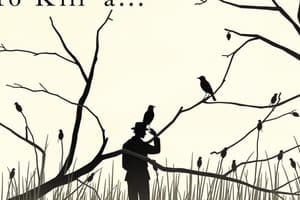Podcast
Questions and Answers
Why does Atticus think it is so important to determine which side of Mayella's face is bruised?
Why does Atticus think it is so important to determine which side of Mayella's face is bruised?
Atticus thinks it is important because it could indicate the person who hit her, particularly since Mr. Ewell is left-handed.
What opinions may be changed by this discovery?
What opinions may be changed by this discovery?
Some opinions that might be changed are about Mr. Ewell possibly staging the beating and rape to get a black man in trouble.
Describe the Ewell's living conditions. What is the one thing they have that makes them better than their nearest neighbors?
Describe the Ewell's living conditions. What is the one thing they have that makes them better than their nearest neighbors?
The Ewells lived behind a dumpster and not many people passed by their house, but they had the privilege of being white.
What is interesting about Mr. Ewell writing on the back of an envelope?
What is interesting about Mr. Ewell writing on the back of an envelope?
Why does Mayella Ewell resent Atticus' manner?
Why does Mayella Ewell resent Atticus' manner?
What is the significance of the fact that Atticus can get only one witness?
What is the significance of the fact that Atticus can get only one witness?
Describe Tom Robinson.
Describe Tom Robinson.
How does Scout think Tom is like Atticus?
How does Scout think Tom is like Atticus?
What is unusual about Dolphus Raymond?
What is unusual about Dolphus Raymond?
What 'mistake' did Tom make in the questioning?
What 'mistake' did Tom make in the questioning?
Why does Scout feel sorry for Mayella Ewell?
Why does Scout feel sorry for Mayella Ewell?
Why does Dill cry?
Why does Dill cry?
Why does Dolphus Raymond pretend to be drunk?
Why does Dolphus Raymond pretend to be drunk?
List all the reasons Atticus brings out to show Tom is innocent.
List all the reasons Atticus brings out to show Tom is innocent.
What does Atticus say to the jury?
What does Atticus say to the jury?
What was the jury's verdict?
What was the jury's verdict?
What does the last line of Chapter 21 mean?
What does the last line of Chapter 21 mean?
How did Atticus react to the kids having been in court?
How did Atticus react to the kids having been in court?
How did Aunt Alexandra react?
How did Aunt Alexandra react?
What is Jem's reaction to the verdict?
What is Jem's reaction to the verdict?
What did Atticus find in his kitchen the next morning?
What did Atticus find in his kitchen the next morning?
What act of kindness did Miss Maudie do for the children the next day?
What act of kindness did Miss Maudie do for the children the next day?
How does Miss Maudie show that Jem has come of age?
How does Miss Maudie show that Jem has come of age?
Why does Miss Maudie explain that Atticus was named to defend Tom Robinson instead of Maxwell Green?
Why does Miss Maudie explain that Atticus was named to defend Tom Robinson instead of Maxwell Green?
What did Bob Ewell do to Atticus?
What did Bob Ewell do to Atticus?
Why does Atticus say Bob Ewell threatened him?
Why does Atticus say Bob Ewell threatened him?
What does he think will come of the threats?
What does he think will come of the threats?
Where was Tom Robinson?
Where was Tom Robinson?
What is Atticus' opinion of any white man who cheats black men?
What is Atticus' opinion of any white man who cheats black men?
What man on Tom's jury wanted an acquittal?
What man on Tom's jury wanted an acquittal?
Name the four kinds of folks Jem says there are in the world.
Name the four kinds of folks Jem says there are in the world.
How many kinds of folks does Scout believe there are?
How many kinds of folks does Scout believe there are?
Study Notes
Key Events and Character Insights
- Atticus emphasizes the importance of identifying which side of Mayella's face was bruised, hinting at inconsistencies in the testimony and possible fabrication of the charges against Tom Robinson.
- The fact that Mayella was not taken to a doctor raises doubts about the validity of her claim of rape.
- Understanding which hand caused the injury could implicate Mr. Ewell, as he is left-handed while Tom Robinson's left hand is disabled.
Perspectives and Social Commentary
- The testimony reveals biases in society; opinions may shift as evidence points to Mr. Ewell staging the attack.
- The Ewells' impoverished living conditions contrast sharply with others, highlighting social hierarchies and the stigma associated with extreme poverty.
Legal Strategy and Courtroom Dynamics
- Mr. Ewell's use of the envelope to write establishes his left-handedness, a strategic observation for Atticus in his defense.
- Mayella's resentment towards Atticus is rooted in her unfamiliarity with respect and kindness, indicating her isolated upbringing.
Themes of Race and Justice
- The trial emphasizes systemic racism, evidenced by the lack of witnesses willing to support Tom Robinson.
- Tom Robinson is depicted as a hardworking man with a family, yet he faces prejudice due to his race.
Emotional Responses and Childhood Innocence
- Dill's emotional reaction to Mr. Gilmer's treatment of Tom reflects the sense of injustice felt by the children, exposing the harsh realities of racism.
- Scout's empathy for Mayella points to her growing understanding of human loneliness and suffering.
Community and Support Systems
- Following the verdict, Jem's devastation illustrates the deep impact of racism on his understanding of morality and justice.
- Miss Maudie's gesture of baking cakes signifies community support and care for the children during a tumultuous time.
Consequences and Retaliation
- Bob Ewell's threat against Atticus underscores the ongoing tension after the trial, revealing the dangers of standing up against racism.
- Atticus's perspective on Ewell’s threats indicates a rejection of fear, reinforcing his moral stance.
Atticus's Values and Morality
- Atticus expresses disdain for any white man who exploits black individuals, reinforcing his principles of equality and justice.
- His steadfast demeanor in the face of adversity represents the moral backbone required to challenge societal injustices.
Family Dynamics and Growth
- Scout’s and Jem's differing views on the world indicate their evolving understanding and maturation amidst complex social issues.
- The characterization of various social groups illustrates the nuances of human behavior and societal structures.
Final Reflections
- The narrative considerations such as Miss Maudie's commentary on Atticus's qualifications signify the complexities of legal morality and racial bias within the justice system.
- The exploration of childhood innocence versus harsh societal realities underlines the overarching themes of empathy, moral integrity, and the pursuit of justice.
Studying That Suits You
Use AI to generate personalized quizzes and flashcards to suit your learning preferences.
Description
Dive into the key themes and important questions from chapters 17 to 23 of 'To Kill a Mockingbird.' This quiz focuses on critical analysis of character motivations and significant events, including Atticus’s observations during the trial. Test your understanding of this classic novel with these flashcards!




